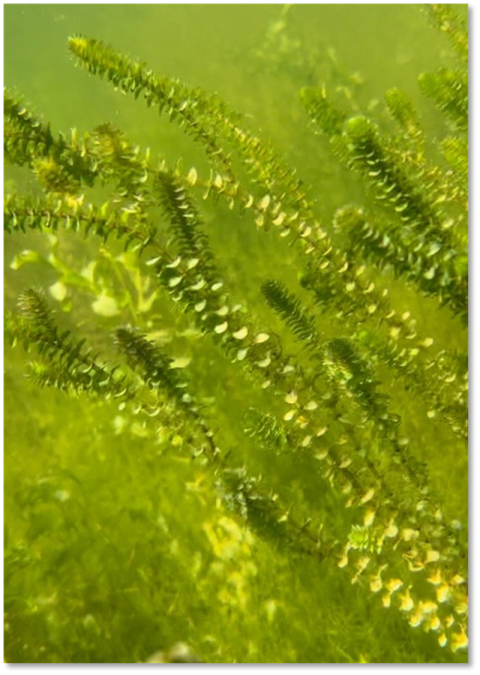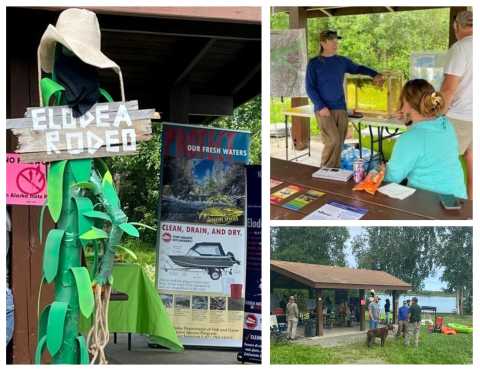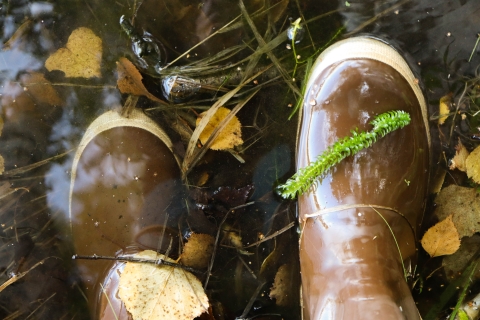With more than 3 million natural lakes in Alaska, the state is a kaleidoscope of freshwater blue. Their diversity is astounding ― lakes may be oblong or circular, deep or shallow, and appear many different hues, from turquoise to navy to midnight. All are found abundantly across the state’s tundra, wetland, alpine, and rainforest ecosystems, and all support entire worlds of life, from tiny microorganisms to families of polar bears.
Few lakes are larger and more important to the Matanuska-Susitna (Mat-Su) Valley than the aptly named Big Lake. Comprising 2,493 acres, it’s roughly the size of 1,917 football fields. Within an hour’s drive from Anchorage, Palmer, and Wasilla, it provides public and private access for many boats and floatplanes, while its large population of sockeye salmon makes it a popular fishing destination for people near and far.
Though unfortunately, sometimes unwanted visitors make the journey to Big Lake, too.
The Elodea Dilemma
Elodea is a more than just an unwanted visitor, it’s Alaska’s first (and only) freshwater invasive plant. Likely introduced to the state from an aquarium that was dumped into a waterbody, the plant has detrimental and far-reaching effects in the lakes, ponds, and sloughs it infests. With just a tiny fragment ― a two-inch piece wrapped around a boat prop or floatplane rudder ― people can unknowingly move Elodea to a new place, where a population can quickly explode. The plant often grows rapidly into dense mats that block sunlight and steals nutrients from native vegetation.
Over time, Elodea reigns supreme in the lakes it inhabits. Other native plants ― which play crucial roles in maintaining water health and providing food, shade, and habitat for species such as sockeye salmon ― are outcompeted. All that remains is Elodea and its harmful impacts to native fish and wildlife. To make matters worse, Elodea survives throughout the winter, continuing to grow beneath the ice.
Researchers from the University of Alaska, estimated that if left unchecked to spread across the state, Elodea could cost the commercial sockeye fishing industry $159 million per year. And the damage to other Alaskan communities, including Alaska Native Tribes, who depend on healthy ecosystems and fish for their economies and rich cultures, is incalculable.
So, when Elodea was discovered in Big Lake in 2019, the Mat-Su Elodea Task Force and its members, including U.S. Fish and Wildlife Service (USFWS) Southern Alaska Fish and Wildlife Conservation Office (SAFWCO), knew they were facing a massive challenge.
Increased Investment Results in Increased Detection
Nicole Swenson, a Senior Aquatic Invasive Species Field Biologist with the USFWS SAFWCO, knows that the best strategies for invasive species invasive species
An invasive species is any plant or animal that has spread or been introduced into a new area where they are, or could, cause harm to the environment, economy, or human, animal, or plant health. Their unwelcome presence can destroy ecosystems and cost millions of dollars.
Learn more about invasive species management are “to prevent their arrival in the first place, find new infestations early, and respond as quickly as possible to known infestations, to prevent them from expanding,” she says.
That’s why the Mat-Su Elodea Task Force ― of which Swenson was a founding member, along with other state, federal, Tribal, municipal partners, and concerned Alaska landowners and residents ― was formed in 2018. Initially, the task force focused on the eradication of Elodea from Alexander and Sucker Lakes. Accessible only by floatplanes, boats, or snowmachines, over half a million dollars were invested to support eradication and surveillance efforts in these hard-to-reach waterbodies.
This initial collaboration prepared the Task Force well for Big Lake. In 2023, prevention and early detection capacity in the Anchorage area increased with the investment in a SAFWCO AIS Program using "Stewardship" funding from Senator Murkowski. With Swenson at the helm and two seasonal biological technicians, the SAFWCO AIS Program got right to work, coordinating with state, federal, Tribal, non-profit, and for-profit partners to implement early invasive species detection and rapid response technologies.
With its partners, the SAFWCO AIS Program conducted 23 surveys for Elodea, invasive Northern pike, and zebra mussels in smaller lakes in Anchorage and the Mat-Su Valley, discovering three previously unknown Elodea infestations.
Big Lake’s Big Problem ― and Big Solutions
But Big Lake was a big job. Completing the first-ever systematic survey of the entirety of Big Lake and its connected waterbodies was more than a one-person, one-team, or even one-agency job. Swenson brought together partners from the Alaska Department of Natural Resources, Alaska Department of Fish and Game, Big Lake Community Council, and a landowner.
In May 2023, armed with detection equipment, GPSs, and waterproof datasheets, the multi-organization, survey crew tackled the Big Lake challenge. Over four days, four boats navigated their course to systematically map all shallow areas of the lake where invasive Elodea could be growing. This survey and resulting infestation map provided a baseline for treatment plans and allowed the group to update containment and treatment strategies currently in progress.
The AIS Program also provided invasive species identification and reporting training to USFWS employees. Already, Alaska’s lakes have benefitted ― in May 2023, a seasonal SAFWCO employee spotted Elodea on a weekend trip to Flat Lake. They took pictures of the plant and reported it, and the Alaska Department of Natural Resources was able to treat the infestation by July, preventing a potential spread from the popular public boat launch.
This further emphasizes benefits of increased AIS capacity in the Anchorage Mat-Su area and importance of outreach to prevent invasive species.
And, in July 2023, to increase public awareness of the impacts of Elodea, the Mat-Su Elodea Task Force hosted an Elodea Rodeo outreach event at Big Lake. Kids’ crafts, watercraft inspection and cleaning demonstrations, Clean Drain Dry materials, Elodea rake throw sampling demonstrations, native vegetation identification, and several other stations marked the event. Plus, it wouldn’t be a rodeo without a cowboy…in this case, a paper mâché giant Elodea cowboy!
An Ongoing Collaboration
Why is the success of surveying Big Lake (and other Southcentral AK waterbodies) such a big deal?
Alaska might be a large state, but it’s all connected. The Anchorage and Mat-Su areas offer important local recreational opportunities, but they also serve as an important jumping off point for to visit the rest of the state ― whether that’s hopping in a floatplane and heading north or jumping in a truck and pulling the boat down to the Kenai Peninsula. Both options have the potential to spread Elodea to new waterbodies.
Knowing the extent of the infestations is the first step in strategizing process for removal. More importantly, it also allows for targeted public outreach. As SAWFCO looks ahead to summer, it’s a great time to celebrate the big progress made at Big Lake.
Thanks to the dedicated efforts led by USFWS Southern Alaska Field Office, and partner agencies, Tyonek Tribal Conservation District, Cook Inlet Aquaculture Association, Alaska Department of Fish and Game, Alaska Department of Natural Resources, Alaska State Parks, Big Lake Community Council, Knik Tribal Council, and Mat-Su Salmon Partnership.
______________________________________________________________________________________________________________________________________
Everyone can help prevent the spread of Elodea and other aquatic invasive species.
Learn to identify Elodea:
- Three leaves whorled around the stem
- Typically leaves are densely packed around the stem
Clean, drain, dry your gear before moving to a new waterbody.
Report any suspected invasive species.
- Call 1-877-INVASIV (1-877-468-2748)
- Use Alaska Department of Fish and Game Online Invasive Species Reporter








